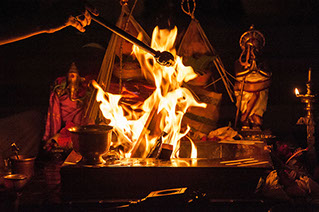



108 Names of Bharat Mata Video
108 Names of Bharat Mata
Gayatri Mantras Video
Bharat Mata Gayatri Mantras
Ekavimski Video
Bharat Mata Ekavimsati Song

Click on Link below to go to Youtube Videos
To download MP3 Audio right click and "save link as"
Home
About the Author
108 Names of Bharatamata
Gayatri Mantras
Ekavimsati Song
Speaking/Media Contact
Sri Bharatamata
Ashtottaram 73
73) OṀ NITYĀGNIHOṪRA BHŨMYAINAMAH:
OṀ (AUM) -NI-TYA-AG-NI- HO-TRA- BHOO- MYAI- NA-- MA- HA
(Nitya: means-performed daily, perpetual, will always be; Agniho'ṫram: means-oblation
to Agni, maintaining and offering to the sacred fire)
Agniho'ṫram means 'in which libations are poured into Agni' (fire). Yajṅa or sacrifice links the human beings with divine beings. When these divinities or devatās are propitiated through Yajṅās, they reward the performers with whatever they desire for. These yajṅās may be nitya (obligatory, performed daily), naimiṫṫika (occasional) or kāmya (motivated). Again, depending upon the materials used they may be classified as pāka-yajṅa, ḥavir-yajṅa and somayāga. Cooked food is offered in pāka-yajṅa and soma juice in somayāgās; milk and ghee are the materials normally used in ḥavir-yajṅa.
Agniho'ṫra is one of the most common and important sacrifices which is classed among the ḥavir-yajṅās and considered to be nitya. It is performed more as a daily worship than for the fulfillment of any specific desire. It should be started from the very evening of the day on which agnyādhāna (establishing the Vedic fire ceremonially) is done. It is obligatory to perform it daily till death or old age or samnyāsa. All the dvijās (the 'twice- born,' the men of the first three varṇās) are entitled to its performance. It must be done twice daily at dawn and dusk, along with the wife. Wife, son or pupil can perform it on his behalf in emergencies. The main part of the rite consists in heating and offering cow's milk in a ladle into the gārhapatya fire with appropriate mantras. Sūrya (Sun) and Prajāpaṫi are the deities to whom offerings are made in the morning, and Agni and Prajāpaṫi, in the evening.
Instead of with milk, the rite may be performed with gruel, cooked rice, ghee or curds when specific fruits or results are desired for. The performer of Agniho'ṫra is obliged to rear a cow. The milk vessel which must be an earthen pot with a straight brim is called 'agniho'ṫra-sthālī' and the ladle 'agniho'ṫra havaṇī.' If and when the yajamāna (performer of the sacrifice) goes on a pilgrimage along with his wife, he can carry the gārhapatya fire with him or can ceremonially put it out and perform punarādhāna (re-establishing the fire) on his return. When he dies, the various wooden implements used by him for Agniho'ṫra should be kept on various parts of his body as prescribed and the body cremated with the gārhapatya fire.
'Something was prescribed in the Vedas, and hence we are doing it'- is not the attitude; instead, we perform the daily oblation to Agni with great understanding of the importance of it spiritually and secularly and our land is 'Nityāgnihoṫra Bhūmi.'

